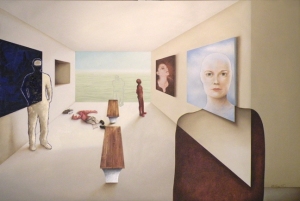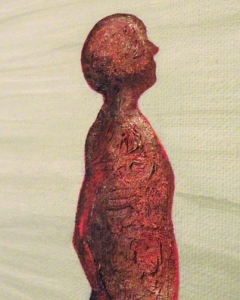I have a little less than 12 weeks left, to have artwork hanging on the walls for my Fall Exhibition, and there is still a lot to be done. Although most of the pieces being showcased are near completion, needing only tweaks and detailing, the big picture is much more comprehensive than the art itself. Those wholly immersed in the business understand the enormity of the task at hand (to do it right, at least). But for the rest of you, regardless of your level of enthusiasm, I hope this small glimpse “Behind the Scenes” will be a fun journey that will also shed some light on all the time, money, and effort that is invested in presenting the work. So, whether the show is well-coordinated or a total disaster… We’ll see soon enough. 🙂
Getting Started:
Foremost among my priorities is creating enough interest in the project to finance it (without loans, barter, or credit). I realistically only have 4 – 6 weeks to raise all the $$$ needed, and the outcome of my effort will directly impact two very specific matters; Location, and Marketing. I knew going into this that raising capital would be the most daunting of my tasks. So of course, I’ve wasted no time. As of now, there are three active prospects with whom I am coordinating studio visits, two of whom I’ve met with casually to discuss the project, my needs, wants, and long term goals. The third is a recent acquaintance with a passionate appreciation for art who has developed a serious interest in my work over the last month. All are solid prospects that I have nurtured. But another potential, a lead with whom I still need to follow up, has been added to the list of hopefuls through referral from a friend. (Much more on these developments later)
Obviously, the objective of the Studio Visit is to generate sales. So I make it a practice to plant the seed early. That way, potential buyers won’t feel blindsided when the subject comes up during the tour. I know. The voice of reason tells you that “the intent to sell” is an understood. But in retort, let me remind you that Assumption is also the mother of all f*ups. I know. I’ve been there and done that. So, I don’t assume. I take a very direct approach instead and put all my cards on the table, plain and simple.
My Selling Philosophy:
I’ll readily admit, I feel fortunate for having been equipped with the ability and eagerness to sell. I don’t know if I was just born lucky, or if my proficiency as a salesman is a skill-set that has been acquired and honed through experience. Probably, it’s a little of both. But I also attribute much of my success to a simple selling philosophy that begins with Knowing One’s Self. Many artists fail to recognize that when a collector acquires art, they’re not just purchasing an image or an object they like, they’re investing in the artist – a living, breathing person with aspirations and beliefs. The artist is the product. Despite the shared enthusiasm in the work itself (which is only a bonus), it is the artist’s persona and vision that gives the work any real value, and it is within the artist that “Potential Investment” can be found.
The principles themselves are simple. Create Value, both in the work and yourself. Make It Personal, because you HAVE TO be more than just a name on the wall next to a piece. Always Offer the Best Deal Possible, which means… Be Fair to Yourself Without Getting Greedy. But most important, you have to Close The Sale (arrange for the client to buy). Chances are, if you’re approach is genuine in all regards, closing the sale is just a formality that ends with a handshake and a happy client. After all, (yes) they are there for a reason (to purchase). But nothing is free in this world. You still have to earn the willing exchange if you want to complete the transaction on fair terms for both parties.
Let me demonstrate how this approach works, by applying it to my upcoming studio visits.
Creating Value: The real advantage to inviting potential buyers into the studio is simple, Seeing is Believing. So I focus on my three greatest strengths, the sheer scale of my collection, diversity, and my attention to detail.
The first part is easy, because the moment my guest steps into the studio… They Are Bombarded… with art, everywhere; hanging on the walls, in progress on my easel, neatly resting on shelves, and peeking out of every nook and cranny. The selection is easily 100 pieces strong, in-house, which can be overwhelming. But that impression alone is generally enough to create a sense of wonderment that establishes grounds for conversation. And 9 times out of 10, they are the ones who break the silence with some variation of exclamation.
The second part requires a little more finesse. You have to listen… to understand what the buyer is looking for. Your job, is to fulfill that need, expressing your appreciation through attentiveness while recognizing your cues to comment. For the most part, the work should speak for itself, because, in all honesty, art is inherently subjective. But its also important to share tidbits about the processes undergone, the concept and what it took to achieve it, because they want to see the work as you do, even if they own a different interpretation of it. But regardless of opinions, there is simply no comparison to seeing the work in full, vivid detail – in person.
Here’s an example of a piece you’d see in my portfolio.
And details you would want to see in person, to fully appreciate their depth in texture and the sensitivity expressed in each brush stroke.
Making It Personal: Making it personal is not just about navigating the one-on-one exchange. It’s about instilling a sense of appreciation in your patron, for the opportunity they provide you by supporting your decision to pursue your passion. Collectors give our work real meaning and purpose when they become our patrons. They become the most vital component in turning a hobby into a career. So I conduct my business with pure, unadulterated gratitude, knowing that every sale will directly flow into preparation for the next project (currently… my Fall Exhibition). It’s not leisure money I’m accumulating. It is necessary working capital. (Everyone will have their own approach to this, but hopefully, you get the gist.)
Offering the Best Deal Possible: This is the most significant benefit for you patron, because it translates directly into savings. I cannot stress this enough.
The art market is still retail, which means heavy markups on the art when purchased through a third party (the gallery). Don’t get me wrong. There are many well-established galleries that can fetch far better prices than I could as an individual, but they are not abundant enough to support the whole of the art community (regardless of skill level and/or experience). Therefore, I prefer to create my own opportunities while continuing my quest for representation, and studio visits have proven to be increasingly lucrative and mutually beneficial (for myself and my collectors).
The simple truth is, when purchasing artwork directly from the artist, the buyer automatically eliminates the added cost of commissions, usually 40 – 50 percent of the sale, which galleries keep. Prices seem exorbitant in galleries because they are (even when the price is justified through the galleries function). I know I’d never take a cut on my part! That means the gallery has no choice but to raise prices, in order to receive its share, while the buyer absorbs the cost. That’s why I’ve grown to appreciate studio visits as a regular part of my business… I feel like I can genuinely offer “Privileged Pricing” for those willing to engage.
Closing the Sale: I realize that not just anyone has two or three thousand dollars in “petty cash”, with which to by art. So, when it’s time to decide on the purchase, I like to guide the buyer through different payment options to provide them with the best solution for their budget. Of course, cash is still king. So I will oftentimes offer a discount for cash purchases, to encourage a full commitment up front (when it is within their means). However, I also accept credit cards and have discovered the added benefit of receiving payment in installments, which can be arranged any number of ways. In fact, I’ve sold more work over the last two years, than ever before, since I started offering Payment Plans (up to 10 months for larger acquisitions). They’ve helped smaller budgets stretch further (for a purchase that is normally out of range) and have proven an effective method in creating a steadier income stream, allowing me to focus more heavily on expanding my audience and growing a business that is built around a labor of love.
In conclusion:
Enough of the groundwork has been laid down, from strategy to production, to achieve my desired outcome… even within a limited time-frame. So as a matter of principle, I prefer to trust my own instincts, now that I’m engaged, rather than rely on conventional Best Practices. I stick with what I know for a host of reasons, but primarily, because it eliminates complications that I’m not prepared for. And that is part of the excitement for me here, whether the show is a success or failure. I get to put my instincts and experience to the test… And it will unfold here, for all to see. This is my life, after all, the life of an artist… and this is “Why” I started this blog. 🙂
~ Stay Tuned!








One thought on “The Crash Course Begins!”